How the dice got their spots
How the dice got their spots
Most people know that the opposite sides of a six-sided die always add up to seven. But what is the relationship between all six sides of a die? How do they wrap around each other?
Set a die down so the six face is on top and the two is facing you. You automatically know the one is on the bottom, and the five is facing away from you. What you can't automatically know is if the four is on the left or the right.
Some dice manufacturers place the four on the left of the dice. Others put the four on the right side. The same dice company may even change faces for different sizes and styles of its dice. Of course, the three is always on the opposite side of the four.
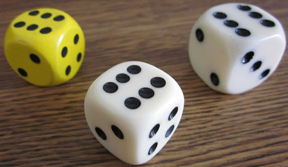
Yellow die has four on the viewer's right side. Middle white die also has a four on viewer's right side. Right white die has a three on viewer's right side.
Another way to think about how the spots are arranged on the dice is to view the three sides of the one, two, and three spots. Some people refer to the different layouts as left or right-handed. I prefer to think of the two layouts as clockwise or counterclockwise.
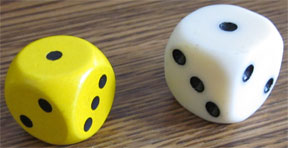
The one, two, and three faces run in a counterclockwise direction on the yellow die and a clockwise direction on the white die.
There are also some interesting differences in how the spots of individual faces are laid out. For example, some Asian dice place the three spots for the three face in a triangle, rather than the traditional diagonal line. You may also see the pair of spots for the two face in a vertical or horizontal line, rather than a diagonal line.
For most six-sided dice the only two faces with spots that are not symmetrical are the two and the three. Both of these numbers usually have the spots run in a diagonal line on that face of the dice. But in which direction? Do the diagonal lines have positive or negative slopes? It turns out that that there are four different ways to lay out the spots for these two faces.
Two of the possibilities are when the line formed by connecting the three spots meets the line formed by connecting the two spots. These two lines can either meet at the corner of the six face or the one face.
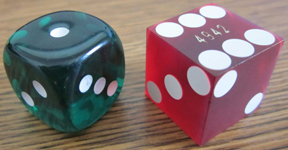
The green die has the two and three sloping up to meet the one. The red die has the two and three sloping up to meet the six.
The lines made by the spots of the two and the three faces don't have to meet at one corner. They can run parallel to each other. Again, there are two different ways in which the two lines can run parallel. Assume the six face is on top and the die is placed so you can see the six, three, and two faces. The lines created by the two and three faces can either be positive or negative slopes.
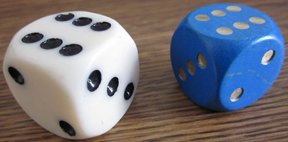
The blue die shows the two and three with positive slopes to meet the six. The white die shows the two and three with negative slopes.
Finally, while the six face is symmetrical those six spots can have two different orientations on that face of the die. The two rows of three spots can run in the same two tracks after bending around to align with the four spots of the four face. The two rows of three spots for the six face can also be placed so they run at a right angle to the four spots of the four face.
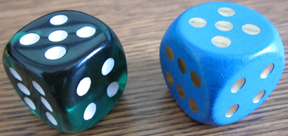
The six spots on the blue die run across to the four. The six spots on the green die run up to the five.
One year the International Jugglers' Association (IJA) held its annual juggling festival at a hotel/casino in Primm, Nevada. You had to walk through the casino to get from one's hotel room to the exhibition hall where the juggling took place. One early morning, about three a.m., I was walking back to my room, through the almost-empty casino. Except for the pit crew, one of the craps tables was empty.
Thinking they might know about the history, I asked the three employees about these subtle differences in the possible orientations of spots on dice. They hadn't given any thought to the idea that the two and three faces could have positive or negative slopes, and they confessed to me that they probably wouldn’t notice the change if someone slipped in a pair of dice that only had that difference.
As we were talking their boss walked up. He had overheard just enough of our conversation to explain that he would notice the difference and wanted to know why his employees wouldn't.
With the realization that the training manual was soon going to be updated, I thought it an appropriate time to leave.
I later contacted a dice manufacturer and was told that there is no reason to explain the difference between various sets of dice. It’s up to the individual designer.
copyright 2010 by Todd Strong

- Home
- About
- Ball Juggling
- Cigar Boxes
- Club Juggling
- Club Swinging
- Comedy Writing
- Cup Stacking
- Devil Sticks
- Diabolo
- Diabolo Postcards
- Dice Stacking
- Hat Manipulation
- Lasso
- Miscellanous Juggling
- Parachute Games
- Poi Swinging
- Ring Juggling
- Shaker Cups
- Skill Games
- Staff
- Tennis Balls and Can
- New Games Foundation
- Ordering and Shipping
- Contact Information
- Peeps (photos of birds and stuff)
- Personal Thoughts
- Workshops
- Links
- Questions? Comments? Feedback?